 |
 |
Our enthusiastic and extremely knowledgeable perennials team is here to answer your questions and help you choose the best perennials for your situation. There’s always something in bloom for sun, shade, butterflies, birds or deer resistance as well as a variety of bulbs for your space.
Stroll through our time-tested favorites and introduce yourself to the newest varieties. We garden with perennials too; we love them and it shows!
|
18 found, showing page 1 of 2
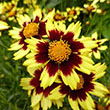
Gold centers are surrounded with a band of deep burgundy that reaches out toward the sunny yellow tips. USDA 5-8
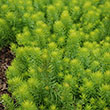
Height: 8 inches
Spacing: 10 inches
Sunlight: full sun, partial shade
Hardiness Zone: 2b
Other Names: Sedum reflexum
Ornamental Features:
Angelina Stonecrop is smothered in stunning yellow star-shaped flowers at the ends of the stems from early to mid summer. Its attractive succulent needle-like leaves remain gold in color throughout the season.
Landscape Attributes:
Angelina Stonecrop is a dense herbaceous perennial with a ground-hugging habit of growth. It brings an extremely fine and delicate texture to the garden composition and should be used to full effect.
This plant will require occasional maintenance and upkeep, and is best cleaned up in early spring before it resumes active growth for the season. Deer don't particularly care for this plant and will usually leave it alone in favor of tastier treats. Gardeners should be aware of the following characteristic(s) that may warrant special consideration:
-Spreading
Angelina Stonecrop is recommended for the following landscape applications:
- Mass Planting
- Rock/Alpine Gardens
- Border Edging
- General Garden Use
-Groundcover
Planting & Growing:
Angelina Stonecrop will grow to be about 8 inches tall at maturity, with a spread of 12 inches. When grown in masses or used as a bedding plant, individual plants should be spaced approximately 10 inches apart. Its foliage tends to remain low and dense right to the ground. It grows at a fast rate, and under ideal conditions can be expected to live for approximately 10 years. As an herbaceous perennial, this plant will usually die back to the crown each winter, and will regrow from the base each spring. Be careful not to disturb the crown in late winter when it may not be readily seen!
This plant does best in full sun to partial shade. It prefers dry to average moisture levels with very well-drained soil, and will often die in standing water. It is considered to be drought-tolerant, and thus makes an ideal choice for a low-water garden or xeriscape application. It is not particular as to soil pH, but grows best in poor soils, and is able to handle environmental salt. It is highly tolerant of urban pollution and will even thrive in inner city environments. This is a selected variety of a species not originally from North America. It can be propagated by division; however, as a cultivated variety, be aware that it may be subject to certain restrictions or prohibitions on propagation.
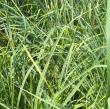
Foliage turns golden orange in the fall. Clump forming. USDA 5-8
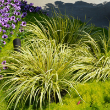
Height: 12 inches
Spread: 12 inches
Sunlight: full sun, partial shade
Hardiness Zone: 4b
Other Names: Sweet Flag Grass
Description:
Though it is commonly known as sweet flag, this is actually a grass, not an iris; iris-like foliage is fragrant and great for moist or boggy areas; it is gold and green-striped but appears mostly gold; doesn't like to dry out or the tips will burn
Ornamental Features:
Grassy-Leaved Sweet Flag is primarily valued in the garden for its ornamental upright and spreading habit of growth. Its attractive fragrant grassy leaves remain gold in color with prominent green stripes throughout the season.
Landscape Attributes:
Grassy-Leaved Sweet Flag is a dense herbaceous perennial grass with an upright spreading habit of growth. Its relatively fine texture sets it apart from other garden plants with less refined foliage.
This is a relatively low maintenance plant, and is best cleaned up in early spring before it resumes active growth for the season. It has no significant negative characteristics.
Grassy-Leaved Sweet Flag is recommended for the following landscape applications:
- Mass Planting
- General Garden Use
- Groundcover
- Naturalizing And Woodland Gardens
- Container Planting
- Bog Gardens
- Planting & Growing
Grassy-Leaved Sweet Flag will grow to be about 12 inches tall at maturity, with a spread of 12 inches. Its foliage tends to remain dense right to the ground, not requiring facer plants in front. It grows at a medium rate, and under ideal conditions can be expected to live for approximately 10 years. As an herbaceous perennial, this plant will usually die back to the crown each winter, and will regrow from the base each spring. Be careful not to disturb the crown in late winter when it may not be readily seen!
This plant does best in full sun to partial shade. It is quite adaptable, prefering to grow in average to wet conditions, and will even tolerate some standing water. It is not particular as to soil type or pH. It is somewhat tolerant of urban pollution. This is a selected variety of a species not originally from North America. It can be propagated by division; however, as a cultivated variety, be aware that it may be subject to certain restrictions or prohibitions on propagation.
Grassy-Leaved Sweet Flag is a fine choice for the garden, but it is also a good selection for planting in outdoor pots and containers. It is often used as a 'filler' in the 'spiller-thriller-filler' container combination, providing a canvas of foliage against which the larger thriller plants stand out. Note that when growing plants in outdoor containers and baskets, they may require more frequent waterings than they would in the yard or garden.
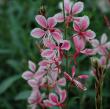
Rose pink blooms on rigid stems. Naturalizing. USDA 5-8 'Siskiyou Pink' prefers full sun and is happy in average to poor, well-drained soil. Wandflower is a tap-rooted perennial so it is very drought tolerant. The tap root makes these difficult to move once they are settled in, so site them carefully.
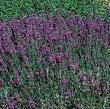
Fragrant purple-blue blooms. Compact mounding foliage. MUST have good drainage USDA 5-8
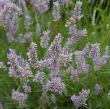
Heavily fragrant light lavender blooms. Silvery mounding foliage. MUST have good drainage. USDA 5-8
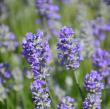
Fragrant purple blooms. Uniformly mounding. Compact. MUST have good drainage. USDA 5-8
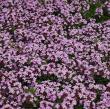
Pink blooms. Fragrant foliage. Evergreen. Moderate foot traffic. USDA 5-8
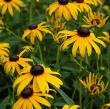
Golden yellow blooms. Long blooming. Compact and bushy. USDA 5-8
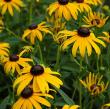
Height: 30 inches
Spacing: 18 inches
Sunlight: full sun
Hardiness Zone: 3a
Other Names: Orange Coneflower, Black Eyed Susan
Ornamental Features:
Goldsturm Coneflower has masses of beautiful gold daisy flowers with dark brown eyes at the ends of the stems from mid summer to early fall, which are most effective when planted in groupings. The flowers are excellent for cutting. Its serrated pointy leaves remain dark green in color throughout the season.
Landscape Attributes:
Goldsturm Coneflower is an herbaceous perennial with an upright spreading habit of growth. Its medium texture blends into the garden, but can always be balanced by a couple of finer or coarser plants for an effective composition.
This is a relatively low maintenance plant, and should be cut back in late fall in preparation for winter. It is a good choice for attracting butterflies to your yard, but is not particularly attractive to deer who tend to leave it alone in favor of tastier treats. It has no significant negative characteristics.
Goldsturm Coneflower is recommended for the following landscape applications:
- Mass Planting
- General Garden Use
- Container Planting
Planting & Growing:
Goldsturm Coneflower will grow to be about 24 inches tall at maturity, with a spread of 24 inches. When grown in masses or used as a bedding plant, individual plants should be spaced approximately 18 inches apart. It grows at a fast rate, and under ideal conditions can be expected to live for approximately 15 years. As an herbaceous perennial, this plant will usually die back to the crown each winter, and will regrow from the base each spring. Be careful not to disturb the crown in late winter when it may not be readily seen!
This plant should only be grown in full sunlight. It prefers to grow in average to moist conditions, and shouldn't be allowed to dry out. It is not particular as to soil type or pH. It is highly tolerant of urban pollution and will even thrive in inner city environments. This is a selection of a native North American species. It can be propagated by division; however, as a cultivated variety, be aware that it may be subject to certain restrictions or prohibitions on propagation.
Goldsturm Coneflower is a fine choice for the garden, but it is also a good selection for planting in outdoor pots and containers. With its upright habit of growth, it is best suited for use as a 'thriller' in the 'spiller-thriller-filler' container combination; plant it near the center of the pot, surrounded by smaller plants and those that spill over the edges. It is even sizeable enough that it can be grown alone in a suitable container. Note that when growing plants in outdoor containers and baskets, they may require more frequent waterings than they would in the yard or garden.
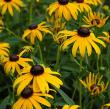
Golden yellow blooms. Long blooming. Compact and bushy. USDA 5-8
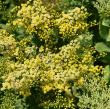
Yellow blooms. Upright foliage. Compact habit. Clump-Forming. USDA 5-8

Ivory rose outward facing blooms. Glossy foliage. USDA 5-8
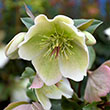
Molly's White Hellebore | White, single-petaled flowers with lime-green accents. Late season bloomer. USDA 4-8
18 found, showing page 1 of 2




